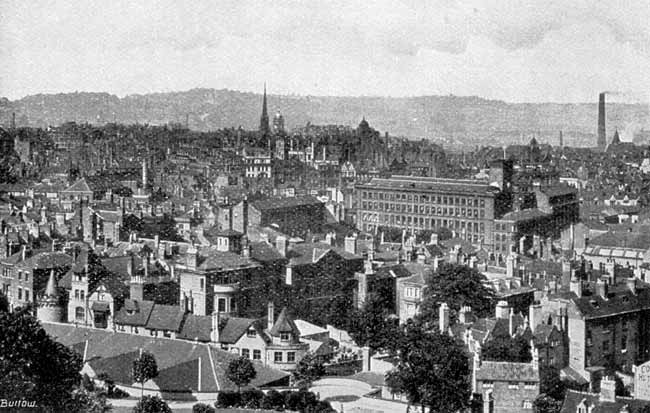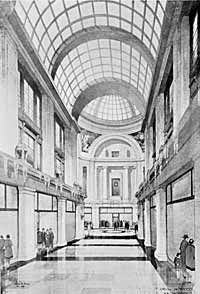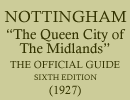NOTTINGHAM IN HISTORY.
The authentic history of Nottingham—one of the "Five Boroughs" of the Danes—really began a little more than a thousand years ago. In the ninth century, the Danes, during one of that series of raids in which they overran and harried the greater part of Anglo-Saxon England, attacked and captured Nottingham; but King Ethelred I and his youthful brother Alfred—afterwards known to history as Alfred the Great—compelled them to make peace and retire to York. This was in the year 868.
For the next seventy years the town had a chequered history. It was repeatedly attacked and taken by the Danes and as often retaken. Edward the Elder, who took it in 924, fortified it with a wall and built a bridge over the Trent, but it was not long before it again fell into the hands of the Danes, who were once more driven out in 940.
The next outstanding event of civic importance was the arrival of William the Conqueror. A wooden fortress was already in existence on the spot where the Castle now stands. This he reconstructed and fortified the town so strongly that it was regarded as impregnable, but fire, one of the great terrors of the Middle Ages, almost entirely destroyed it in the following century—first in 1140 and again in 1153.
In the reign of Edward III three Parliaments were held at Nottingham between 1330 and 1337, one of which passed the first laws prohibiting the exportation of English wool and for the encouragement of foreign manufacturers to settle in England.
Edward IV was proclaimed king in Nottingham in 1460. In the year 1534 Nottingham received its first suffragan bishop, and in 1642 Charles I, at the outbreak of the Civil War, unfurled his standard on a hill outside the Castle, and still known as Standard Hill. The town was shortly afterwards taken by the Parliamentary forces and strongly garrisoned under the famous Colonel Hutchinson.
It was at Nottingham in 1811 that the Luddites, bands of workmen who went about the Midland counties destroying machinery, began their activities. The lack of work which prevailed at the time, due to a great wave of commercial depression, was attributed to the introduction of machinery and the wrecking campaign of the Luddites continued sporadically for the next four or five years.
Nottingham's first charter was granted by Henry II in 1155. A charter of Henry VI, granted in 1448, constituted it a distinct county with its own Lord Lieutenant and Sheriff and its own Assizes. It is a county borough under the Local Government Act of 1888, a city by Royal Charter granted in 1897, and returns four members to Parliament, representing the Central, South, East and West Divisions. It is governed by a Mayor, 16 Aldermen and 48 Councillors.
Among the notable men of Nottingham birth were Henry Kirke White, the poet, who was born in 1785, and died while an undergraduate at St. John's College, Cambridge, in 1806, at the age of twenty-one; Philip James Bailey (1816-1902), the author of "Festus," a poem which was once immensely popular and won fame for its author before he was twenty-four; the Rev. Gilbert Wakefield (1756-1801), classical scholar of Jesus College, Cambridge; William Vialls, founder of loan clubs; and General Booth, founder of the Salvation Army, who was born in 1829.

Bird's eye view of north-east Nottingham.
NOTTINGHAM FOR THE VISITOR.
THE GUILDHALL.
Parliamentary powers have been obtained for the acquisition of a site on which to erect a new and larger Guildhall to accommodate the whole of the municipal departments. The existing Guildhall has its main entrance in Barton Street, and contains, besides municipal offices, two oak-panelled Police Courts, while at the rear of the building is the Fire Station, with a spacious yard for drill and exercise purposes, with an entrance from Sherwood Street. On the first floor is the Grand Jury Room, a fine apartment containing portraits of Sir John Turney (who, until he retired from municipal life, was the "Father" of the City Council), Sir Charles Seely, Sir Edward Fraser, Sir Samuel G. Johnson (for many years Town Clerk of Nottingham) and of Nottingham's gallant airman, Flight-Commander Albert Ball, V.C., who had the honour of being made a Freeman of the City at the age of twenty. He lost his life in the service of his country three months after. Flight-Commander Ball's record was remarkable in every respect. He accounted, during the war, for no fewer than 50 enemy aircraft, and was a most brilliant and determined fighter. In addition to receiving the V.C. he was awarded the D.S.O. (with two bars), the Military Cross, the medal and diploma of the Aero Club of America, and was made a Chevalier of the Legion of Honour. He also received the Russian Order of St. George. A memorial to this gallant airman stands in the Castle Grounds.
THE EXCHANGE.

A shopping arcade in the new Exchange.
The old Exchange with its stuccoed front which faced the Great Market Place for two hundred years has been razed to the ground. The demolition included an adjacent congeries of shambles and shabby shops, and the visitor will now see rising on the site a great new Exchange which, when completed in a year or two, will be one of the most stately, handsome and distinctive of English Civic Buildings. This is the most important and ambitious of many improvements planned in Nottingham or any other provincial city for many years.
The reproduction of drawings by the Architect, Major T. Cecil Howitt, D.S.O., A.R.I.B.A., on pages 16, 27 and 45 of this book convey some idea of what the new Exchange will look like when completed. In addition to providing accommodation for municipal purposes upon a scale and in a character worthy of Nottingham's status as a great Midlands city, the building will include business premises of an attractive kind which should materially advance Nottingham's reputation as a shopping centre. The internal arrangement of the great building will be cruciform, each arm of the cross forming a lofty and imposing arcade lined on each side with shops. Those who are acquainted with the similarly arranged Galleria Vittoria Emanuele at Milan may be excused for hoping that, like its magnificent Italian counterpart, the great building now rising at Nottingham may be something more than a shopping centre—that it may become also a social rendezvous, a focus-point of all that is most fashionable and colourful, attractive and interesting in the daily life of a great city.
